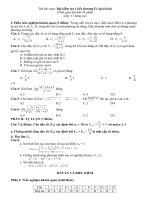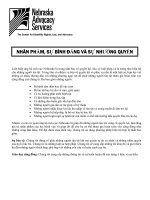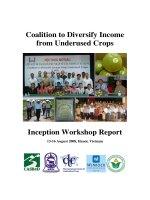UBI-GM-Presentation12.050112-product pptx
Bạn đang xem bản rút gọn của tài liệu. Xem và tải ngay bản đầy đủ của tài liệu tại đây (1.67 MB, 21 trang )
Products and Services for Consumers
Chapter 12
McGraw-Hill/Irwin © 2005 The McGraw-Hill Companies, Inc. All rights reserved.
PowerPoint presentation prepared by:
Alfred Lowey-Ball
Associate Professor of Marketing
UBI-United Business Institutes
Brussels, Belgium
Chapter Outline
•
Disney World-wide
•
Quality
•
Definition and maintaining
•
Physical or mandatory requirements and adaptations
•
Green marketing and product development
•
Products and culture
•
Innovative products & adaptation
•
Production and diffusion of innovations
•
Analyzing product components for adaptation
•
Core, packaging and core components
•
Marketing consumer services globally
•
Service opportunities & barriers
•
Brands in international markets
•
Global & national brands
•
Country effect
•
Private brands
•
Disney World-wide
•
Quality
•
Definition and maintaining
•
Physical or mandatory requirements and adaptations
•
Green marketing and product development
•
Products and culture
•
Innovative products & adaptation
•
Production and diffusion of innovations
•
Analyzing product components for adaptation
•
Core, packaging and core components
•
Marketing consumer services globally
•
Service opportunities & barriers
•
Brands in international markets
•
Global & national brands
•
Country effect
•
Private brands
Chapter Learning Objectives
1. The importance of offering a product suitable
for the intended market
1. The importance of offering a product suitable
for the intended market
2. The relationship between product acceptance
and the market into which it is introduced
2. The relationship between product acceptance
and the market into which it is introduced
3. The importance of quality and how quality is
defined
3. The importance of quality and how quality is
defined
4. Country-of-origin effects on product image
4. Country-of-origin effects on product image
6. The need to sell all product attributes to over
resistance to acceptance
6. The need to sell all product attributes to over
resistance to acceptance
5. Physical, mandatory and cultural requirements
for product adaptation
5. Physical, mandatory and cultural requirements
for product adaptation
McGraw-Hill/Irwin © 2005 The McGraw-Hill Companies, Inc. All rights reserved.
Chocolate Confectionaries in Russia
•
Quality critical to gaining market share: in the
90’s, western chocolate products conquered
Russia: Mars, Toblerone, Cadbury’s
•
Then, local Russian products eg « Red October »
regained market leadership and ousted the
western brands
•
Maintaining quality critical to keeping market
share:
•
Product dumping by producers,
•
Product abuse in distribution (insufficient control)
•
Performance quality problem
Introduction
•
The opportunities for international marketers of consumer goods
and services today have never been greater
•
New consumers are springing up in many emerging markets,
which promise to be huge markets in the future
•
In the more mature markets consumers’ tastes become more
sophisticated and complex due to increases in purchasing power
•
The difference between tangible products and services
•
The difference between business-to-consumer and business-to-
business markets
Quality
•
Intense global competition is placing new
emphasis on manufacturing quality products
•
Quality, as a competitive tool, is the deciding
factor in world markets
Quality can be defined on two dimensions:
(1) performance quality: does the product meet specs and
do the job?
(2) Market perceived quality: the entire package of utility
and experience that is provided
•
Quality is customer satisfaction: ie. the degree to which customer
expectations have been met.
•
Quality is measured in many industries by objective third parties, in the US
by agencies such as JD Power and Associates
•
Customer satisfaction indexes are now being used to measure satisfaction
across a wide variety of consumer products and services
•
Quality is customer satisfaction: ie. the degree to which customer
expectations have been met.
•
Quality is measured in many industries by objective third parties, in the US
by agencies such as JD Power and Associates
•
Customer satisfaction indexes are now being used to measure satisfaction
across a wide variety of consumer products and services
•
Global competition places a greater emphasis on product
quality
•
Quality is the single most important attribute for
marketing success
Quality
•
Intense global competition is placing new
emphasis on manufacturing quality products
•
Quality, as a competitive tool, is the deciding
factor in world markets
Quality can be defined on two dimensions:
Performance quality: does the product meet specs and
do the job?
Market perceived quality: the entire package of utility
and experience that is provided
•
Quality is customer satisfaction: ie. the degree to which customer
expectations have been met.
•
Quality is measured in many industries by objective third parties, in the US
by agencies such as JD Power and Associates
•
Customer satisfaction indexes are now being used to measure satisfaction
across a wide variety of consumer products and services
•
Quality is customer satisfaction: ie. the degree to which customer
expectations have been met.
•
Quality is measured in many industries by objective third parties, in the US
by agencies such as JD Power and Associates
•
Customer satisfaction indexes are now being used to measure satisfaction
across a wide variety of consumer products and services
•
Global competition places a greater emphasis on product
quality
•
Quality is the single most important attribute for
marketing success
Physical or Mandatory Requirements and Adaptation
•
Products may have to change to meet the physical or mandatory
requirements of a new market, ranging from simple package changes to
total redesign of the physical core product
•
Examples:
•
Rewiring for local mains voltage
•
relabelling for local language
•
Special air filters and clutches for hot dusty countries in Mid East
•
Product homologation is used to describe the changes mandated by local
product and service standards
•
Examples:
•
Video game content must meet local statutory requirements for
sex violence (EU in general is very strict)
•
Special labelling for GM foods
•
Products may have to change to meet the physical or mandatory
requirements of a new market, ranging from simple package changes to
total redesign of the physical core product
•
Examples:
•
Rewiring for local mains voltage
•
relabelling for local language
•
Special air filters and clutches for hot dusty countries in Mid East
•
Product homologation is used to describe the changes mandated by local
product and service standards
•
Examples:
•
Video game content must meet local statutory requirements for
sex violence (EU in general is very strict)
•
Special labelling for GM foods
Green Marketing and Product Development
•
EU is at the forefront of the “green movement,” with strong
public opinion and specific legislation favoring environmentally
friendly marketing and products.
–
Legislation controlling plastic packaging waste
–
Consumer demand for “environmentally” friendly products (Voluntary)
–
Examples:
•
aerosol propellants that do not affect the ozone layer
•
Biodegradable, non-polluting detergents
•
In some countries (in the EU) each level of the distribution chain
is responsible for returning all packaging, packing, and other
waste materials up the chain
•
These trends are transferring to the US and other countries
Products and Culture
(1) core component, the product “platform” (ie. its
technology), design features and functional
features. It is at this level that product
variations are made to adapt to local differences.
(2) packaging component, includes price, quality, the
package itself, labelling, styling, brand name etc.
(3) support services component, includes
instructions, installation, warranties, deliveries,
repair and maintenance, and availability of
spare parts
(1) core component, the product “platform” (ie. its
technology), design features and functional
features. It is at this level that product
variations are made to adapt to local differences.
(2) packaging component, includes price, quality, the
package itself, labelling, styling, brand name etc.
(3) support services component, includes
instructions, installation, warranties, deliveries,
repair and maintenance, and availability of
spare parts
A product is more than a physical item: It is a bundle of satisfactions (or
utilities) that the buyer receives, including how it performs in use, its form,
taste, color, odor and texture, its package and label, the warranty, the
accompanying service and its prestige and image
A product is more than a physical item: It is a bundle of satisfactions (or
utilities) that the buyer receives, including how it performs in use, its form,
taste, color, odor and texture, its package and label, the warranty, the
accompanying service and its prestige and image
Product Components
Product Adaptation
•
.The adoption of products by consumers is influenced by how
the “total” product conforms with a culture’s norms, values,
and behavior patterns
•
As cultures vary, products will need to be adapted
accordingly
Illustrations:
•
Coke in Japan, Mid East
•
Shiseido (J) in USA
Product Innovation
Any product or concept perceived as new by a group of
people or culture. Innovation’s characteristics:
Relative advantage Complexity Observability
Compatibility Triability
Any product or concept perceived as new by a group of
people or culture. Innovation’s characteristics:
Relative advantage Complexity Observability
Compatibility Triability
Product diffusion Process by which an innovation spreads
Marketing strategy can foster and control the rate of diffusion to some
extent
Influenced by three variables: degree of newness, perceived product
attributes, method used to communicate the idea
Product diffusion Process by which an innovation spreads
Marketing strategy can foster and control the rate of diffusion to some
extent
Influenced by three variables: degree of newness, perceived product
attributes, method used to communicate the idea
Production of Innovations rate differs among cultures
Production of Innovations rate differs among cultures
Marketing Consumer Services Globally
1. intangibility,
2. inseparability,
3. heterogeneity, and
4. perishability
Consumer services are distinguished by four unique
characteristics:
Consumer services are distinguished by four unique
characteristics:
•
There are several services opportunities in global markets from
tourism, airline travel, TV, movies and health care services to
financial services
•
There are several services opportunities in global markets from
tourism, airline travel, TV, movies and health care services to
financial services
Barriers to Entering Global
Markets for Consumer Services
•
protectionism,
•
controls on transborder data flows,
•
protection of intellectual property, and
•
cultural requirements for adaptation
including language
•
Most services are inseparable and require production and
consumption to occur almost simultaneously; thus, exporting is
not a viable entry method for them
•
Most services are inseparable and require production and
consumption to occur almost simultaneously; thus, exporting is
not a viable entry method for them
•
Globally, consumer services marketers face the following four
barriers:
•
Globally, consumer services marketers face the following four
barriers:
Brands in International Markets
1. Global brands such as Kodak, Sony,
Coca-Cola, McDonald’s, Toyota,
and Marlboro play an important role
in that process
2. Perceived brand “globalness” leads to
increases in sales
A global brand is defined as the worldwide use of a name, term,
sign, symbol (visual and/or auditory), design, or combination
thereof intended to identify goods or services of one seller and
to differentiate them from those of competitors
A successful brand is the most valuable resource of a company
Brand image is at the very core of business identity and strategy
A global brand is defined as the worldwide use of a name, term,
sign, symbol (visual and/or auditory), design, or combination
thereof intended to identify goods or services of one seller and
to differentiate them from those of competitors
A successful brand is the most valuable resource of a company
Brand image is at the very core of business identity and strategy
Top Global Brands
Insert Photo of two cars
Country-of-Origin Effect and
Global Brands
• Brands are used as external cues to taste,
design, performance, quality, value, and
prestige
•
Many factors affect brand image, but one factor
of great concern is the country-of-origin effect
on the market’s perception of the product
• Country-of-origin effect (COE) can be defined
as any influence that the country of
manufacture, assembly, or design has on a
consumer’s positive or negative perception of a
product
• When the customer becomes aware of the
country of origin, there is the possibility that the
place of manufacture will affect product or
brand image
•
The country, the type of product, and the image
of the company and its brands all influence
whether the country of origin will engender a
positive or negative reaction
Private Brands vs Manufacturer’s Brands
•
Private brands are owned by retailers rather than
manufacturers
•
Tend to provide a minimum guaranteed quality at a
cost effective price
•
Receive preferential shelf space and in-store
promotion
•
Offer the retailer a higher margin than manufacturer’s
brands
•
Wave of the future for “generic” consumer goods sold
in department and grocery supermarkets?









